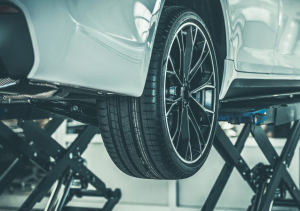How do you know when it’s time for a tire rotation at your Honda dealer? Turns out there’s some ways to tell when it’s time for this essential service.

Signs It’s Time for a Tire Rotation From Your Honda Dealer
Uneven Tread Wear
Regularly inspect your tires for signs of uneven wear patterns, such as one side of the tire being more worn than the other or the center wearing out faster than the edges. This uneven wear can affect the vehicle’s handling and overall safety.
Vibration or Noise Issues
If you start noticing unusual vibrations or noise while driving, especially at higher speeds, it could be a sign that your tires are wearing unevenly and need to be rotated. These vibrations can often be felt through the steering wheel or the floor of the car.
Decreased Fuel Efficiency
Tires that are not rotated regularly can lead to decreased fuel efficiency. Unevenly worn tires can increase rolling resistance, making your engine work harder and thus consume more fuel. If you notice a sudden drop in your vehicle’s miles per gallon, consider checking your tire condition.
Time and Mileage Check
A general rule of thumb for rotations is every 6,000 to 8,000 miles, or as recommended by your vehicle manufacturer. Keeping track of the mileage since your last rotation can help you stay on top of necessary maintenance.
Tire Pressure Monitoring System Alerts
Most newer Hondas will have a Tire Pressure Monitoring System (TPMS) that can alert you to issues with your tires. While TPMS is primarily for monitoring tire pressure, frequent alerts can also be an indication of uneven wear and the need for a rotation.
Handling and Traction Problems
If you begin to notice changes in your vehicle’s handling, such as difficulty turning corners or reduced traction during acceleration, this could be a sign that your tires are wearing unevenly and affecting the car’s performance.
Visual Assessment of Tire Condition
Regularly take the time to visually assess the condition of your tires. Look for signs of balding, bulges, or other irregularities. If these issues are more pronounced on one tire compared to others, it’s likely time for a rotation.
Seasonal Changes
Consider rotating your tires with seasonal changes, especially if you live in an area with significant weather variations. This practice can ensure even wear throughout the year and extend the overall life of your tires.
Tire rotations will extend the life of your tires, save you money on gas and early tire failure, and makes blowouts less likely. If it’s time for a rotation, visit Superior Honda right away.





